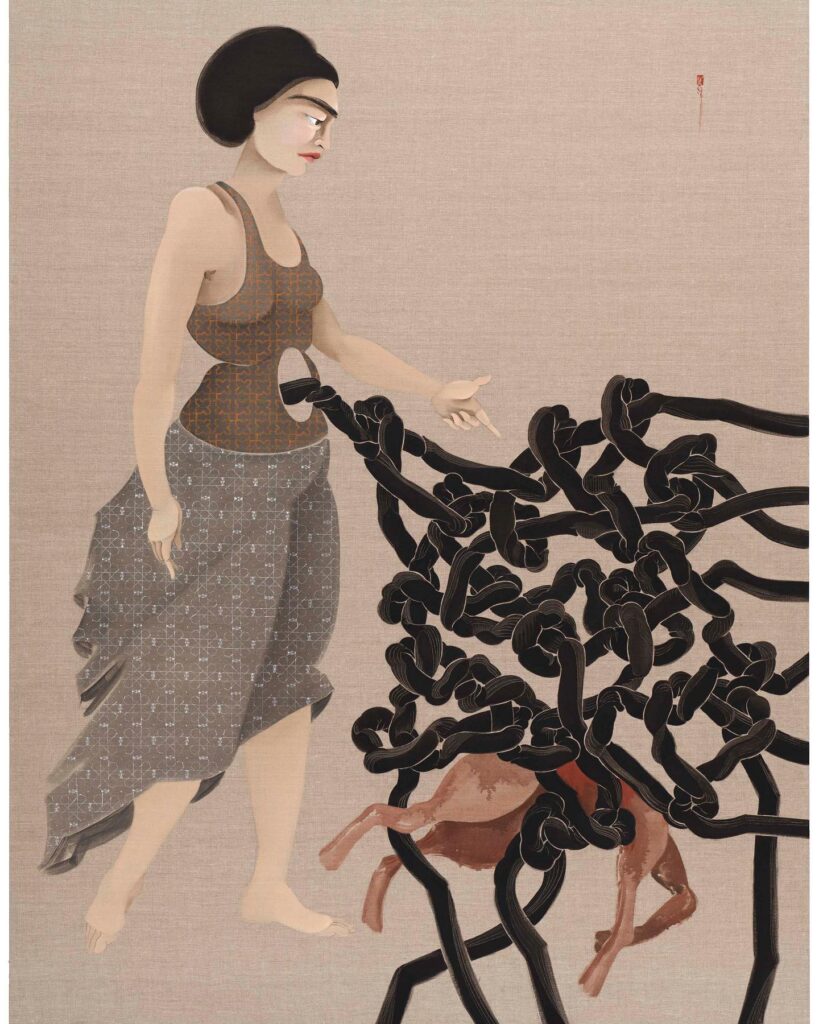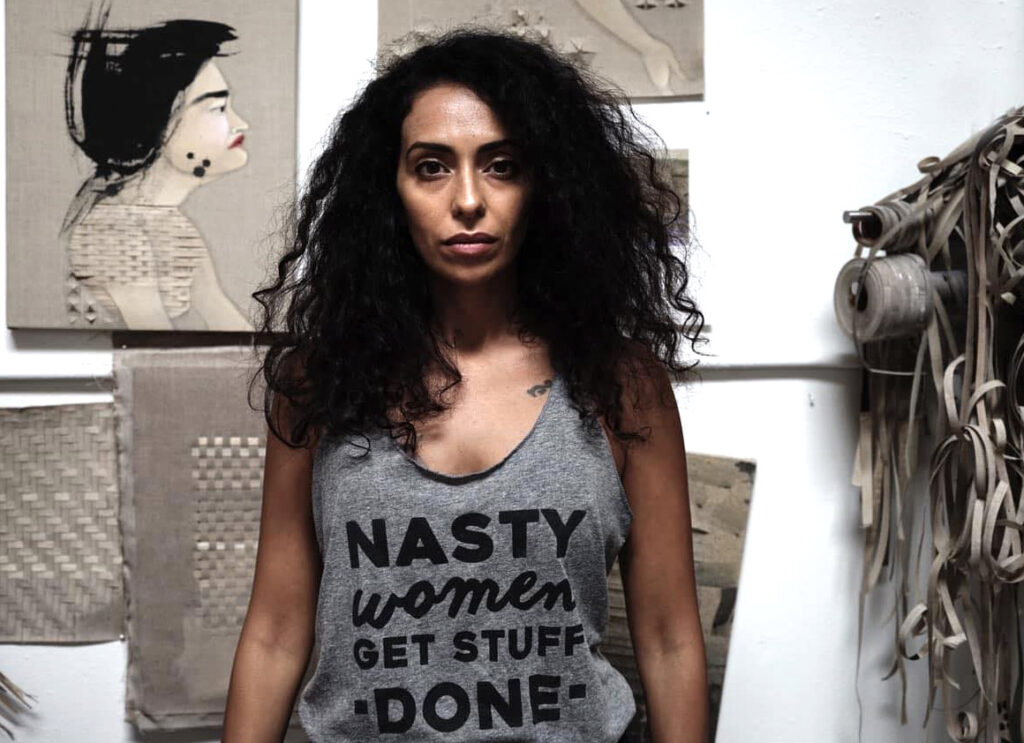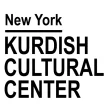Hayv Kahraman, Painter
Hayv Kahraman was born in Baghdad in 1981. Her mother is Kurdish. Her secular parents “would hold soirees, gathering musicians and artists. I would sit in the adjacent room with my paper and paintbrush making quick strokes of color and every now and then one of those artists would come into the room, give me a mini critique and shower me with praise. I also remember my playroom in our house in Baghdad, where I used all four walls as my canvas and filled them with characters, narratives, concerns, jokes, and discoveries.”
When she was twelve, her family fled Baghdad as part of the exodus of Kurds fleeing Saddam Hussein’s brutal regime. Her family settled in Umea, northern Sweden, where Hayv attended school and tried to fit in. But “I was clearly the ‘other’ as literally everyone around me was tall and blond.” In middle school an art teacher mentored and encouraged her interest in painting.
She later moved to the United States and currently lives in Los Angeles.


Her work is semi-autobiographical, and the body—“She”—is her central subject, appearing in most of her paintings. It is her own body, a dark-haired woman with strong brows, red lips, and pale skin. “The body is … our common denominator,” she says. “it’s a language that we all possess.”
But Kahraman is interested in the body in the sense not of the individual but of the collective. She repeats the pale, dark-haired female figure, in different configurations and poses, from one painting to another, with subtle variations. Through repetition, “She” becomes a symbol for the collective female experience, especially Middle Eastern women living in the Western world.
Using the “She” figures, she explores the sense of displacement experienced by refugees and immigrants in the West. The figures have no background or context, like uprooted people, in a state of in-between like herself. “I was riddled with the guilt of moving to the United States in the midst of a sectarian war in Iraq,” she has said. “Here I was, buying a Snicker’s bar at Target while my fellow countrywomen and men were dying. I needed an outlet, and that was paint. What surfaced was a host of violent paintings dealing with issues such as female genital mutilation, honor killings, and beheadings.”
 Her first major show in New York was Let the Guest Be the Master in 2013, which incorporated female figures within wooden panels that were based on floor plans of houses in Baghdad.
Her first major show in New York was Let the Guest Be the Master in 2013, which incorporated female figures within wooden panels that were based on floor plans of houses in Baghdad.
In 2015 her show How Iraqi Are You? was an exploration of her experiences of exile and identity in exile, but also worked with her memories of Iraq. Although her themes can be dark, her style borrows from the traditions of Persian miniatures, Japanese illustration, Renaissance painting, and illuminated Arab manuscripts. She is particularly inspired by the Maqamat (Assemblies) of Al-Hariri is an illuminated Arabic manuscript in the 13th century. It is a classic of Arab literature, created by the Arab poet al-Hariri of Basra. It consists of tales of Abu Zayd, a kind of trickster in different situations. It also conveys the story of everyday people in the medieval Arab world, with illustrations that focus on the figure, not on the background.
At one point Kahraman spent four years in Florence, Italy, “going to every single museum and gallery and doing copies of the old masters. This is where ‘she’ started emerging. Her white, diaphanous flesh, her contrapposto. She was an expression of who I had become as an assimilated woman.”
Kahraman experiments with the feminization of masculine subjects. In Curfew a photograph of soldiers celebrating on the back of a pickup truck is overlain with tumbling female bodies gesticulating in conversation with gauzy dresses slipping off their shoulders.
Kahraman’s work has grown ever more rich and diverse. Read more about her work in the sources below.
A list of exhibitions of her work (up to 2017) is available on her website, here.
Read about her exhibition Look Me in the Eyes in San Francisco, March 2024, here.
Read about her exhibition at the Institute of Contemporary Art in San Francisco, May 2024, here.

Sources
Antoon, Sinan. “Re-membering the Present and Unpacking Memory,” HayvKaharaman.com, 2017.
Daughtry, Martin. “Audible Inaudible,” HayvKahraman.com, 2016.
Finkel, Jori. “Hayv Kahraman on the Kurdish Exodus—And the Trouble with Humanitarian Campaigns,” Art Newspaper, September 21, 2018.
Grönlund, Melissa. “Audible Inaduble,” Art Agenda, 2016.
Kahraman, Hayv. Interview by Broadly Vice, n.d.
Kahraman, Hayv. Interview by Glass Magazine, 2016.
Kahraman, Hayv. Interview by Natasha Morris, 2016.
McGovan, Brooke Lynn. “Penetrating the Silence,” HayvKaharaman.com, 2016.
Memarian, Omid. “Art in the Territory of Excellence: Hayv Kahraman’s Celebration of Memory, Femininity, and Liberation,” HuffPost, December 24, 2017.
Mohseni, Yasmine. “Beyond the White Cube: The Rich Mosaic of Hayv Kahraman’s Art and Life,” HuffPostBlog, December 6, 2017.
Rao, Mallika. “An Exile From Iraq Paints Herself Into Ancient Manuscripts,” HuffPost, March 6, 2015.
Smith, Roberta. “Hayv Kahraman: ‘How Iraq Are You?'” New York Times, 2015.
Wilson-Goldie, Kaelen. “Critic’s Cpick,” Artforum, 2017.
Zaya, Octavio. “Are We Not All Foreigners?” HayvKaharaman.com, 2015.
Photographs of the artist and her work are taken from her social media accounts















